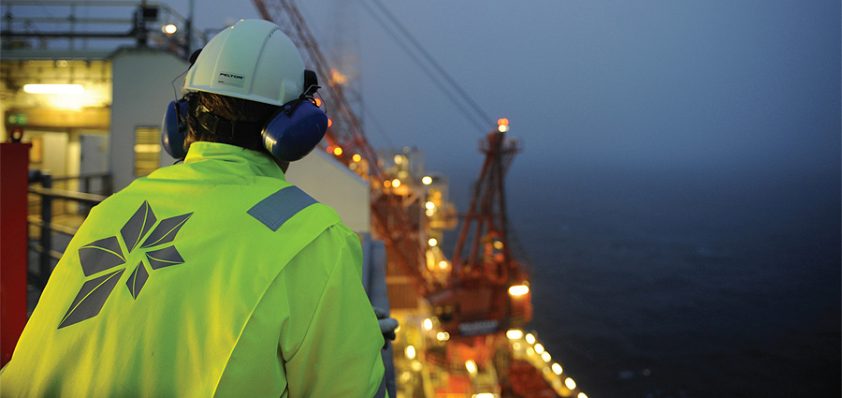
Troll Field
Field of dreams
Containing about 40 per cent of total gas reserves on the Norwegian continental shelf (NCS), the Troll Field represents the very cornerstone of Norway’s offshore gas production.
StatoilHydro has been working to ensure profitable recovery of the thin oil zones in the Troll field since the mid-1980s, and the company is dedicated to continuing its efforts to develop and employ new know-how and technology in order to ensure optimal capture of value related to the Troll oil resources.
 Currently, Statoil operates the Troll A, B and C platforms and the landfall pipelines, while Gassco is operator for the gas processing plant at Kollsnes on behalf of Gassled. StatoilHydro is the technical service provider for Kollsnes operations. Three chartered drilling rigs are currently drilling production wells on the field and long-term contracts have been signed in order to maintain the drilling activity at this level.
Currently, Statoil operates the Troll A, B and C platforms and the landfall pipelines, while Gassco is operator for the gas processing plant at Kollsnes on behalf of Gassled. StatoilHydro is the technical service provider for Kollsnes operations. Three chartered drilling rigs are currently drilling production wells on the field and long-term contracts have been signed in order to maintain the drilling activity at this level.
The Troll field lies in the northern part of the North Sea, around 65 kilometres west of Kollsnes, near Bergen. The field comprises the main Troll East and Troll West structures in blocks 31/2, 31/3, 31/5 and 31/6. In 2002 the oil production from Troll was more than 400,000 barrels per day, and the enormous gas reservoirs lying 1400 metres below sea level are expected to produce for at least another 70 years.
Astrid Sørensen, head of the Troll area for Statoil gives a brief overview of the sheer scale of the development: “The Troll oil and gas field in the North Sea covers 750 square kilometres, which is more than one hundred thousand football fields. It is the largest gas discovery made in the North Sea.”
She continues: “But it’s more than a gas field. The Troll oil history is a very exciting one; filled with brave decisions, thin oil columns, piloting new technology and so forth. The oil reservoirs are historically in the Troll West oil province, which is one of the most productive oil fields on the Norwegian continental shelf. Initially, oil production at Troll was not considered to be economically viable, and at first we started drilling oil layers 22 to 26 metres thick, but now we can drill in four metre thick zones.”
Astrid went onto to explain that Troll is one of the most exciting fields in the Statoil portfolio, because it contains both oil and gas resources. Further exciting developments at the site are due to be announced soon, as she explains: “Giant sized modifications and extensions projects are imminent, and we will utilise considerable resources over the coming years to secure major deliveries from the field. Recovery of both oil and gas will be at a maximum. Building extension work on the Troll A living quarters is already well underway and the same can be said for the assembly of a low-pressure production plant on Troll C. Other important projects include the gas injection plant on Troll B, the new rich gas pipeline from Troll A to Kollsnes, and in time the two new compressors on Troll A. These investments will amount to more than NOK 20 billion in the period from 2009 to 2015.”
The Troll site has reaped more rewards for Statoil than simply oil and gas production, as Astrid explains: “Troll is a laboratory. It significantly enhances our ability to push technology development and implement it. Through this kind of innovation, we have become a world leader in operations designed to increase oil and gas recovery. Our skills in multilateral drilling and completion with  advanced wells have been crucial to our success on Troll oil. Maximum reservoir contact is the key to increase recovery from the thin oil zones at Troll. To achieve this we have placed more than 1,000,000 metres of multilateral wells at the site, with individual lengths up to 7700 metres.
advanced wells have been crucial to our success on Troll oil. Maximum reservoir contact is the key to increase recovery from the thin oil zones at Troll. To achieve this we have placed more than 1,000,000 metres of multilateral wells at the site, with individual lengths up to 7700 metres.
“Troll is also an example of our ability to develop profitable value chains for gas from field to market. Its big reserves prompted the creation of new transport solutions and opened the way to producing smaller discoveries in the area. The field is a key element in the Norwegian gas machine that we’ve been one of the principal architects in building up.”
Astrid concludes with some insight into Statoil’s goals for the future: “The economic turndown has not affected the plans for developing the Troll field. Our overall goal with the field project is to maintain a gas capacity of 120 million scm per day from Troll A. At the same time we will continue to push for new technology, utilising all the experience available to us in order to increase oil recovery on the Troll field. The final aim is to extract nearly 1.9 billion barrels.”
Statoil believes that a considerable potential exists to increase the recoverable reserves in the field. Astrid finishes: “We believe the Troll field will continue to supply Europe with safe, climate-friendly energy through seabed pipelines for many decades to come. But to us Troll is more than Norway’s largest gas field, and more than a hub for developing unique horizontal drilling techniques. We believe that Troll is a state-of-mind – and we’re very proud of it.”
Troll Field
Services: Oil and gas